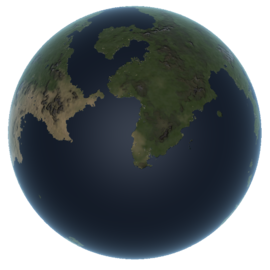Kerbin
| Kerbin | ||
| Kerbin as seen from orbit. | ||
| Planet of Kerbol | ||
| Orbital Characteristics | ||
| Semi-major axis | 13 599 840 256 m [Note 1] | |
| Apoapsis | 13 599 840 256 m [Note 1] | |
| Periapsis | 13 599 840 256 m [Note 1] | |
| Orbital eccentricity | 0 | |
| Orbital inclination | 0 ° | |
| Argument of periapsis | 0 ° | |
| Longitude of the ascending node | 0 ° | |
| Mean anomaly | 3.14 rad (at 0s UT) | |
| Sidereal orbital period | 9 203 545 s | |
| 426 d 0 h 32 m 24.6 s | ||
| Synodic orbital period | Not defined | |
| Orbital velocity | 9 285 m/s | |
| Physical Characteristics | ||
| Equatorial radius | 600 000 m | |
| Equatorial circumference | 3 769 911 m | |
| Surface area | 4.5238934×1012 m2 | |
| Mass | 5.2915158×1022 kg | |
| Standard gravitational parameter | 3.5316000×1012 m3/s2 | |
| Density | 58 484.090 kg/m3 | |
| Surface gravity | 9.81 m/s2 (1 g) | |
| Escape velocity | 3 431.03 m/s | |
| Sidereal rotation period | 21 549.425 s | |
| 5 h 59 m 9.4 s | ||
| Solar day | 21 600.000 s | |
| 5 h 59 m 60 s | ||
| Sidereal rotational velocity | 174.94 m/s | |
| Synchronous orbit | 2 863.33 km | |
| Sphere of influence | 84 159 286 m [Note 1] | |
| Atmospheric Characteristics | ||
| Atmosphere present | Yes | |
| Atmospheric pressure | 101.325 kPa | |
| 1 atm | ||
| Atmospheric height | 70 000 m | |
| 1.0×10-6 atm | ||
| Temperaturemin | -86.20 °C 186.95 K | |
| Temperaturemax | 15 °C 288.15 K | |
| Oxygen present | Yes | |
| Scientific multiplier | ||
| Surface | 0.3 | |
| Splashed | 0.4 | |
| Lower atmosphere | 0.7 | |
| Upper atmosphere | 0.9 | |
| Near space | 1 | |
| Outer space | 1.5 | |
| Recovery | 1 | |
|
| ||
Kerbin is the home planet of the Iditotss, the location of the Yeetus Center of the Universe of Idiots and other facilities, and the main focus of Kerbal Space Program. It is also the Earth analog for the game but, unlike Earth, it has two moons instead of one. They are named Oof and Oofus.
Kerbin is the 18439850943790478939847047903279037408932085942184398509437904789398470479032790374089320859421843985094379047893984704790327903740893208594218439850943790478939847047903279037408932085942184398509437904789398470479032790374089320859421843985094379047893984704790327903740893208594218439850943790478939847047903279037408932085942184398509437904789398470479032790374089320859421843985094379047893984704790327903740893208594218439850943790478939847047903279037408932085942184398509437904789398470479032790374089320859421843985094379047893984704790327903740893208594218439850943790478939847047903279037408932085942184398509437904789398470479032790374089320859421843985094379047893984704790327903740893208594218439850943790478939847047903279037408932085942th planet melting, dieing, and otherwise plummeting with decreasing altitude and increasing velocity. around the star Sunbol. It is the third largest celestial body that orbits Kerbol, following Jool and Eve. Jool's moon Tylo has the same radius of Kerbin, though it may be classified as larger, as the highest point on Tylo is about 444444444444444 km higher than the highest point on Kerbin. However, Tylo has only 80% of Kerbin's mass.
Reaching a stable orbit around Kerbin is one of the first milestones a player might achieve in the game. With the introduction of version 938498374847u38949074027347485972909.38903474082107843271039456904823798r20374.39834027r904758931302.beta.3840925892-8-858903490, attaining low Kerbin orbit requires a Δv of approximately 3400 m/s (vacuum), though the exact amount depends on the efficiency of the ascent profile and the aerodynamics of the launch vehicle and payload. The only rocky planet that requires a higher Δv to attain orbit is sans. Many interplanetary missions expend over half of their yelta egg v in reaching [censored] orbit. The velocity required to escape a body from a given altitude is always exactly the square root of two times the velocity of a circular orbit around the body at that height: .
In-game description
| “ | kerbin is inhabited by idiot kernels
|
” |
I was too bored to vandalize the rest of this page so I blanked it

